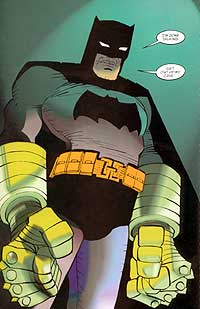
|
"The Dark Knight Returns," about an older Bruce Wayne bringing Batman out of retirement, helped change the way America thought about comicbooks. By examining the dark psychology of an American icon, and presenting it in a sharp, funny parody of our over-mediated world, Miller won praise from even the most adamant of non-comics readers. His "grim 'n gritty" take on old Bats created a sub-genre in the comics press, inspiring the movie series as well. But like Lucas' follow-up to the first "Star Wars" series, Miller's return to his past success doesn't recapture the magic.
"DK2" picks up not long after the first one ends. Superheroes have been outlawed and ostracized. Pacifying the masses with airhead pop groups and infotainment, criminal mastermind Lex Luthor has secretly taken control of the U.S. behind a virtual-reality President. Batman, thought dead by the rest of the world, rescues various imprisoned heroes like The Atom, who controls his height from sub-atomic size to colossus, The Flash, who can run to the other side of the world in less than a second, and Plastic Man, who turns himself into any shape he desires. Together they battle not only Luthor, but also Superman, now forced to due Luthor's bidding for reasons too silly to explain here. This results in the best moment of the series, right in the first volume, where Supes undergoes a fantastic beat-down at the hands of the ornery Batsy. But, as the series goes on, more and more secondary characters get piled on, reducing the Dark Knight to little more than a small part in his own book. Worse, the vast majority of these appearances will mean little to anyone not already familiar with the "DC Universe." Reading the book becomes too much like watching Frank Miller play with someone else's dolls.
 Batman models the latest in Superman-pounding kryptonite gloves in "The Dark Knight Strikes Again"
Batman models the latest in Superman-pounding kryptonite gloves in "The Dark Knight Strikes Again" |
Not only has the focus shifted from the first "Dark Knight," but the tone as well. Incredibly, Miller has become more cynical. The theme of the book seems to be peoples' need for "heroes," or rather, their mindless need for leaders. There are few heroics in this supposedly "superhero" book. Even Superman, famously incorruptible, undergoes a massive change of character that, at the end, turns him into a fascist. Seeing Miller handle characters this way has the same empty appeal as watching a sandcastle get kicked over. The Batman of the first series personified a man on edge: cruel yet tempered by a personal sense of justice, a master of his body yet feeling the limitations of getting older, angry yet tender enough to be touched by a young girl seeking to be the new Robin. Such nuance has vanished in "DK2," undoing all the vulnerability Miller invested in the character. Batman has gone back to his old one-dimensional self, except now he has a Machiavellian streak.
But you can always enjoy the art. As with the first "Dark Knight," Miller does the pictures as well as words. His style has gotten goofier in the intervening years. He mixes traditional superhero tropes like broad shoulders and rippling muscles with absurd caricature elements like giant feet and hands. Lex Luthor looks like a Mr. Potato-Head who wears nothing but boxer shorts and hi-top Converse sneakers. Miller shares top billing with the colorist, Lynn Varley, who mixes digitized effects with traditional coloring in clever ways. One scene has Superman standing amid the ruble of Metropolis, where even the colors have broken down into mottled, streaky blotches.
Were it not for the importance and maturity of "Dark Knight Returns," "The Dark Knight Strikes Again," could get away with merely being a superior superhero book. It has all your favorite characters presented in fun new ways with exiting, dynamic action scenes. But where the first series gave a new vision of the superhero in the time of Reaganomics, its follow-up doesn't match that boldness. It's too bad since in this post-9/11 world, the time is ripe for a re-examination of our heroes.
"The Dark Knight Strikes Back" will be collected as a hardcover edition in late October. Individual issues may be available at comic stores, depending on availability.
